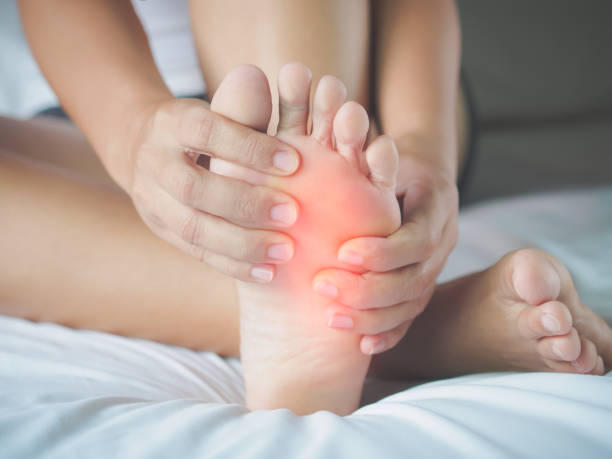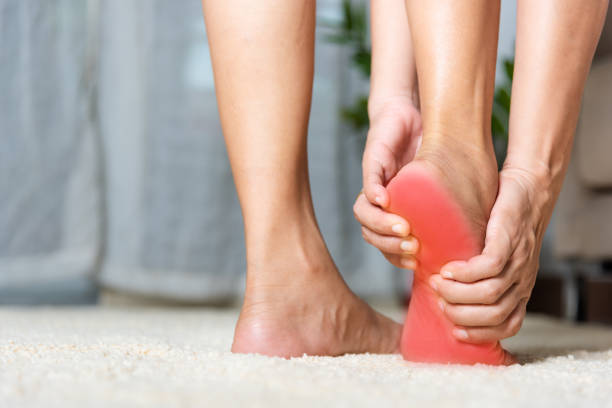Your feet are like health barometers, ready to give you valuable clues about your overall well-being. Pay attention to them and see your podiatrist if you experience any of the following warning signs.
Your podiatrist will start with a thorough medical history check followed by a physical examination of your feet and ankles. They may also order diagnostic tests such as X-rays and blood work.

1. Pain in Your Toes or Feet
Pain in your feet and toes is a common sign you should see a podiatrist. This pain may be caused by overuse of your foot and ankle or from an injury. It could also be a sign of a medical condition like arthritis, diabetes or a blood clot in the leg/foot.
Any pain that persists and doesn’t get better with home treatment or over-the-counter medication is a sign you need to visit a podiatrist. It is especially important to see a podiatrist if your pain is accompanied by other signs of infection, such as redness, warmth, tenderness and a high fever.
Swelling in your feet and toes is another serious warning sign. If your feet and toes are swollen and do not go down after being elevated, it could be due to an injury, blood clot, kidney issues or heart/circulation problems. It could also be a sign of an undiagnosed medical condition like psoriasis or cancer.
If you have diabetes, it’s important to see a podiatrist regularly for preventive care. Talaria Podiatrist of Thornbury can help keep your feet healthy and prevent diabetic neuropathy, in which the high levels of glucose damage nerves in the feet and legs. In addition, a podiatrist can spot discolored spots under your nails, which are often a sign of melanoma (cancer). It’s always better to be safe than sorry.
2. Swelling in Your Feet
While it’s common to experience occasional swelling in your feet and ankles after prolonged standing or walking, persistent or worsening swelling warrants attention. If you find yourself facing frequent or unrelieved swelling, it’s advisable to search for “podiatry near me” online with a lot of recommendations and select a podiatrist to address your concerns. Swelling in the ankles and feet can signal various health issues, such as blood clots, heart disease, or liver and kidney problems. Additionally, swollen feet may indicate Morton’s neuroma, a condition stemming from nerve compression in the foot. Don’t hesitate to seek professional guidance for proper diagnosis and treatment.
Your podiatrist will be able to provide you with foot health services like custom orthotics in Thornbury that will help reduce the pain and improve your ability to walk normally again. For example, your podiatrist may recommend that you wear different shoes or use padding to ease the pain in your feet and ankles. Your podiatrist can also treat foot deformities such as bunions, which form when the bones in the front part of the foot become displaced. A bunion can cause heel pain, affect your gait and make wearing shoes difficult or painful.
The best way to know when to see a podiatrist is to talk to your family doctor about your foot and ankle concerns. Your family doctor can provide you with a referral to see a podiatrist if necessary. In addition, your podiatrist can refer you to a specialist such as a cardiologist for your heart and circulation issues or a nephrologist for your kidney and liver problems.

3. Calluses or Corns on Your Feet
Corns and calluses are areas of hardened skin that develop when a certain area is rubbed or scraped. They may be painful and can bleed when cut. If they are painful or interfere with walking, a podiatrist can diagnose and treat them. They can also help you avoid getting them in the future.
A health care provider can usually diagnose corns and calluses by looking at them and asking about your feet, shoes, and physical activities. They may want to watch you walk or stand and may take X-rays of your feet. If the corn or callus hurts, bleeds easily, or becomes inflamed, seek medical care right away. This is especially important if you have diabetes or poor circulation, since an infected corn can lead to an ulcer.
You can usually prevent calluses and corns by avoiding the friction that causes them to form. Wearing shoes that fit and using pads can keep your feet healthy. Make sure to get your feet measured by a shoe store clerk before you buy new shoes, so that you can be assured of a good fit. If you develop a callus or corn, try soaking it in warm water for several minutes and then using a pumice stone to remove the thick skin. If the corn or callus bleeds when you cut it, see your doctor right away — this could indicate an infection.
4. Numbness in Your Feet
Having numb feet is more than just the foot and toes “falling asleep.” It can be a sign of serious medical conditions, such as diabetes and nutrient deficiencies. If numbness is sudden or prolonged, it’s important to visit a podiatrist for treatment before long-term damage is done.
Numbness in the feet is most commonly caused by reduced blood flow or pressure on nerves. This can be a result of injury, such as a fall or car accident. It can also be a symptom of a neuroma, a benign growth that occurs around a nerve, such as the peroneal nerve between the third and fourth toes (Morton’s Neuroma). Sometimes numbness is caused by poor posture or tight clothing or footwear that restricts blood flow to the feet and toes.
If you experience numbness that is not caused by an injury, it may be a sign of multiple sclerosis (MS), which can cause the loss of balance and sensation in the feet and toes. Numbness is often one of the earliest symptoms of MS and needs to be evaluated right away to prevent long-term problems. A foot doctor can prescribe medication to calm irritated nerves and help slow the progression of diabetic neuropathy. They can also recommend proper shoe gear, orthotics and physical therapy to increase circulation and prevent complications.